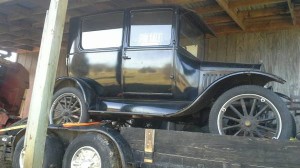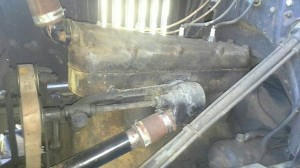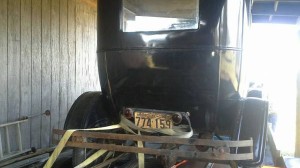
All right, get your minds out of the gutter. This is a discussion about classic Fords! First up is a 1924 T-model, two-door sedan, found on here on craigslist, and located in Bonne Terre, Missouri. The name of the town means “good ground” or “good earth”, presumably named by early settlers contemplating future farming prospects. Although it wasn’t grown locally, this car looks like something I’d expect to find in a place where such praise is used to describe the very ground upon which this car stands.

Though likely still located on the flipper’s trailer when photographed, this car still looks very good in the few photos offered. The asking price is $8,000.

The seller says it runs and has a good title. He uses the words “barn find” and if this car isn’t original, it at least has been the recipient of a very sympathetic and correct-looking restoration at some point in its distant past.

The seller says the interior is complete, but needs to be re-done. It would have been nice to see a photo or two of that. But the outside looks great and the car will probably sell quickly at this price.

Next up, is a 1930 A-Model pickup. The tip on this one was provided to us by reader Matt K. This one can be found here on ebay, and is located in Kingwood, Texas, which is a northern suburb of Houston. It has a Buy-It-Now price of $6,000 or best offer. In Model A parlance, it is sometimes referred to as a CCPU, that is ‘closed-cab pick up’, this of course differentiating it from the more rare roadster pickups, as well as from the model AA heavy duty and commercial chassis trucks of the day.

Interesting also due to it’s completeness and current state of assembly, as so many vehicles this old now come in baskets. It has later model wheels, but the seller’s brief description doesn’t mention those or any other modifications. The photo of the engine reveals that it is not in running condition, and is missing some parts. Fortunately, for Model A owners, everything is replaceable.

Several of the photos also show that it has lots of corrosion and will therefore needs lots of patch panels before it can ever be made shiny again. The seller says it has a Kansas title, but this looks like a lot of rust even for that area of the country. Maybe it spent a lot of time with no glass in it, or was filled with leaves or something? But there is lots of it still here to work with, including the bed, rear fenders and tail gate. Again, not impossible to find, but as all of us know, it adds up quickly.

Chances are, this will end up becoming a rat rod, or a street rod, rather than being restored as a stock Model A. If it were yours, what would you do with it though? And which of these two cars would you rather have?


I’m not familiar with the market for cars this old but the first one looks like it would be to have.
As I have mentioned before, not only the metal work needed, but under that metal is a wood frame that will need to be addressed. I don’t know how prevelant termites are in that part of the country, but if termites are a known problem, you’ll find them waving at you when you uncover the wood frame. I do love this style of “A”, I see its future as a hot rod as those back fenders are begging for some nice wide tires! With all the work that needs to be done to this A, I think the price is too high, something in $3-4K range might be better.
On the other hand, that T looks great! Nice price on it, that should be for sale too long!
Something just occurred to me, would the T have safety glass in it? Pretty sure that was not around in 1924, correct me if I am wrong. I would hate to be in an accident in a car with what amounts to window glass in it.
Hi Barry, I don’t think it had safety glass. I believe, windshields were an option on Model T’s, and most were probably lucky to have anything at all. According to this site, safety glass was around back then, and Ford did use it in the later 20’s, but wasn’t used across the board until 1936. http://www.secondchancegarage.com/public/windshield-history.cfm
Howard is right. Safety glass was not available until the late 20’s. In fact, that was one of the reasons so few closed cars were sold then. People were afraid of the glass shattering when hitting a bump.
Model T’s are all flat glass so it easy and common to replace with laminated glass.
Oh Marty, how could you? We’re supposed to “keep it clean”. Giving us fodder like that. :)
The Model T, I have no connection to, ( except that it is a car) but what a find! The Model A pickup, however, is pretty cool. I think it may turn into a “hot rod”, but that’s ok, as long as it still somewhat resembles a Model A pickup when they’re done. Been sittin’ a while, but this is what they will look like if you want one. Another great find.
The pickup is not running?? I thought they came from the factory with wireless spark plug cables! Lol
great halloween props in the making jejeje
but thats just me ….
but that model A truck would make for a good toy properly modified with a flat head V8
re: termites-
Model A trucks had very little body wood, so no problem there.
the rustout and half-assed rapair all around the bottom of the cab is another story.
if that is a factory steel top, it is less common and more desirable.
still a major undertaking for all but the most skilled metalworker, so the price is a little ambitious.
we LOVE the Model T and it would be a great tour car!
I love the way these goofy sellers think they’re “selling a barn find”. What they’re selling is a car they snagged from someone’s barn, and hustled onto their trailer. You cannot “sell” the thrill or experience of finding an old car in a barn – that is a one-time event, experienced only by those who were actually there!
Is the “T’s” side mounted water pump a common accessory piece?? All of my post WWII Ford Anglias up to about 1958 or so had no water pumps whatsoever, relying simply on thermo-siphon. They never over-heated either. I can’t imagine that the “T” was more advanced in that regard.
Well Something I know a lot about, Bonne Terre, MO, At one time the richest lead ore in the world was located in Bonne Terre and surrounding area. The French discovered lead in Bonne Terre in 1720 and they called the settlement “La Terre Bonne”, “Good Earth”, in reference to the mineral wealth. The actual town was formed in April 1864, when St. Joseph Lead Co. purchased 946 acres of land. The City of Bonne Terre was incorporated as a third class city in 1917.
Now some of you might wonder how I know this, because I grew up in the town of Elvins, Missouri, which is now part of Park Hills. Elvins like Bonne Terre was a Lead Mining town, the Old Lead Belt was in this area until 1972, when St Joe Lead Company moved all operations south by about 50 to Viburnum, Mo. because it was cheaper to mining the ore. The area was dotted with Chat Dumps for years until the EPA decided they were a health hazard, and made the current Company Doe Run Lead Company cover them all with rock.
Elvins was located 6 miles south of Bonne Terre, and today I own a parts store in Festus which is 35 miles north of Bonne Terre.
I also know the Model T, it is a nice car the last time I saw it, that is no lie, and the man that owns it has taking care of it, but I hear his health was bad and somebody else bought the car to sell or flip. I just don’t know if it would be worth his asking price. This weekend I might go by and check it out, it has been a few years since I last saw the old car.
OK History Lesson Over.
Mike, thanks for the correction about Bonne Terre. Now tell me why they changed the name of the town of Flat River?
My cousin and I were allowed to tour the old milling complex there at St. Joe, right around the time the state took it over to open Missouri Mines State Park. We spent a half a day on our own unguided tour, checking out the old buildings, many still filled with stuff left behind by the company. St. Francois, Reynolds and Iron Counties are my favorite local getaways.
Well that is a story in itself, back in the first part of 1992, there where 6 Small Old Mining towns all around the St Joe Lead Company with many of them having mines shafts in them. Bonne Terre there original St Joe Lead mine had stopped lead production in the late 50’s. After the lead mines closed up and moved to Viburnum, the towns just basically dried up so to speak. Many of the miners moved closer to Viburnum instead of driving 100 miles a day through some good old back country 2 lane roads. The Towns where Elvins (which I grew up in), Flat River, Rivermines and Esther (They all had a mine shaft in them at one time, with like Elvins had 2 up till the time they shut them all down for production on July 31, 1972.) they were all so small that they decided to look into consolidating into 1 bigger town to help with taxes, Fire protection, and so on. 3 of the towns had their own Volunteer Fire Departments, and Rivermines was actually called an Unincorporated Village. Flat River had the most people living in it with around 1500, Elvins had 1200, Esther about 750, and Rivermines had 200, before the mines closed down they all add about 25% more people. At first they approached the other 2 small towns of Leadington, and Desloge. After a major vote of the people of these 6 towns, the only towns that agreed was the 4 I listed. So after a commission was made up they applied to the State of Missouri. This was a landmark consolidation, because not all the 4 towns shared a city border with each other, which was a problem at first because in the past in Missouri the other towns that had consolidated were at least bordering each of the towns. Well anyway after the State passed a ruling saying they could do it another vote was held and passed in all 4 town by a landslide margin. So effective January 1, 1994, the towns became Park Hills. I still live just outside of town about a mile out of what was Esther. Over the years the other 2 towns have had an on going battle with Park Hills, because the water dept. which had been controlled by St Joe Lead Co, well Flat River took over control of it and before consolidation and then Flat River build a sewer collection/treatment plant, and to the cities that did not want to join us, Park Hills now charges them a higher rate and then St Joe State Park and the State of Missouri approached Park Hills to annex the Park and all 5000 acres with in the city, the County annexed the County Fair Grounds into Park Hills, so the town of Leadington sued the State of Missouri to stop them because now Park Hills basically surrounds the city of Leadington. By the way the population of Leadington is 225 people, it is an incorporated Village. But it has HWY 67 runs thru the edge of the town and it is a speed trap to the maximum!!!!!
So I hope I helped to answer your questions.
I used to play in the old Federal Mill Complex (which is now the Historic Site) after they shut it down, until it became a state park and Historic Site also!!!!